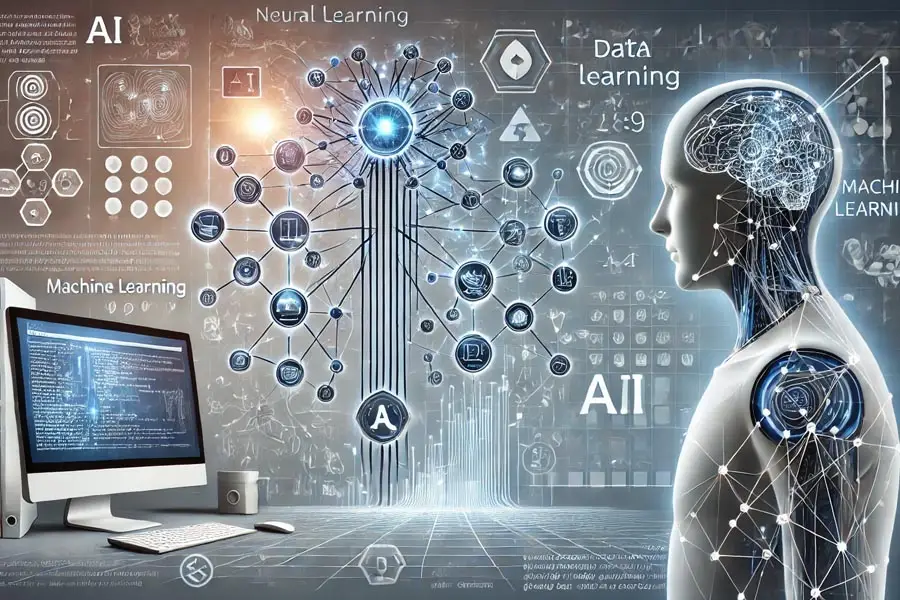With the capacity to execute tasks including language processing, image recognition, and even decision-making that normally need human intelligence, artificial intelligence (AI) has emerged as a game-changing technology. However, how can AI truly pick up these skills? Neural networks and algorithms, which serve as the basis for educating computers to think and behave intelligently, are at the core of AI learning. The basic principles of AI learning and the part algorithms and neural networks play in this process will be discussed in this essay.
1. Understanding the Basics of AI Learning
Fundamentally, AI learning is teaching a machine to use data to make decisions or predictions. Algorithms, which are collections of guidelines or instructions that assist the AI in analyzing data, identifying trends, and eventually learning from that data, direct this process. Artificial intelligence (AI) systems learn by being exposed to data and gradually increasing their performance, in contrast to traditional programming, where engineers explicitly write every command.
There are three main types of AI learning:
- Supervised Learning: Each input in the labeled data used to train the AI has a known output. By predicting outcomes and making adjustments in response to accurate responses, the AI gains knowledge.
- Unsupervised Learning: Data is provided to the AI with no labels or expected results. It is frequently used for association and grouping since it can recognize patterns and structures on its own.
- Reinforcement Learning: Like training a pet, the AI learns by interacting with its surroundings, earning rewards for acceptable behaviors and penalties for undesirable ones.
2. The Role of Algorithms in AI Learning
The mathematical processes that enable AI to learn from data are called algorithms. AI uses a variety of algorithms, each of which is appropriate for a particular purpose. Here are a few instances:
- Linear Regression: a straightforward approach for making line-of-best-fit value predictions. It is applied to jobs in which the input and output have a linear connection.
- Decision Trees: Like humans, this system divides data into branches according to several decision points. In categorization problems, decision trees are frequently employed.
- K-Nearest Neighbors (KNN): This technique, which is employed in tasks like picture and speech recognition, groups data points according to how close they are to one another.
- Support Vector Machines (SVM): By determining the best border between data points from various categories, this method classifies data.
Each of these algorithms has its own strengths and weaknesses, and choosing the right one depends on the specific problem at hand. Many AI applications use a combination of algorithms to achieve the best results.
3. Neural Networks: The Building Blocks of Deep Learning
One of the most effective and widely used technologies for AI learning is the neural network. Neural networks, which are modeled after the organization of the human brain, are made up of layers of interconnected nodes, or “neurons,” that collaborate to evaluate data. A tiny bit of information is processed by each neuron, and the network learns by modifying the connections between neurons in response to feedback.
In a typical neural network, there are three main types of layers:
- Input Layer: transfers the raw data to the following layer after receiving it.
- Hidden Layers: The data is processed and features are extracted by these intermediate levels. Neural networks are commonly referred to as “deep” networks since they might contain several hidden layers.
- Output Layer: produces the final outcome, which may be a decision, prediction, or categorization.
4. Backpropagation and Training in Neural Network Learning
Neural networks learn by varying the weights of connections between neurons in order to reduce prediction mistakes. We call this method backpropagation. The network generates predictions during training, evaluates them against the actual outcomes, and determines the error. The network can then modify the weights and increase accuracy by sending the error back through it.
Neural networks may go through thousands of epochs during training to get the optimal results. Each repetition of this process is referred to as an epoch. A network’s ability to identify patterns and generate precise predictions improves with the amount of data it has and the number of epochs it trains on.
5. Types of Neural Networks
There are several types of neural networks, each suited to different types of tasks:
- Convolutional Neural Networks (CNNs): CNNs, which are mostly used for image recognition, are very good at tasks like object and facial recognition because of their layers, which automatically identify edges, colors, and textures in images.
- Recurrent Neural Networks (RNNs): RNNs are perfect for language processing and translation tasks since they are made for sequence-based data, such as text or time series, and their loops allow information to persist.
- Generative Adversarial Networks (GANs): comprise two networks, a discriminator and a generator, that compete with one another to produce new data, such as text or images, more effectively. Many AI-powered content creation tools are based on GANs.
6. Challenges and Limitations of AI Learning
Despite their strength, algorithms and neural networks have drawbacks. For neural networks to function well, enormous volumes of data must be collected, which can be expensive and time-consuming. Furthermore, massive neural network training requires a significant amount of processing power, which not all enterprises can afford.
The black box problem is another difficulty: neural networks, particularly deep networks, are frequently hard to decipher, making it challenging to comprehend how they arrive at judgments. In industries where explainability is crucial, like healthcare and banking, this lack of transparency may be an issue.
7. The Future of AI Learning
Researchers are looking into novel neural network topologies and algorithms as AI develops further in an effort to increase interpretability, accuracy, and efficiency. AI is becoming more adaptable and quicker to train because of methods like transfer learning, which enables AI to apply knowledge acquired from one task to another. Furthermore, developments in quantum computing might soon allow AI to perform intricate computations even more efficiently than it can now, creating even more opportunities for AI learning.
Conclusion
In order to evaluate data, identify patterns, and generate predictions, artificial intelligence (AI) learning is a complicated yet intriguing process that depends on algorithms and neural networks. These techniques, which range from simple supervised learning algorithms to complex neural networks, are essential to AI’s capacity for learning and adaptation. Knowing the basics of AI learning demystifies the technology and enables us to see its significant influence on a variety of industries. AI learning has the ability to change many facets of our daily lives and provide solutions for some of the most difficult issues facing humanity as it develops.

